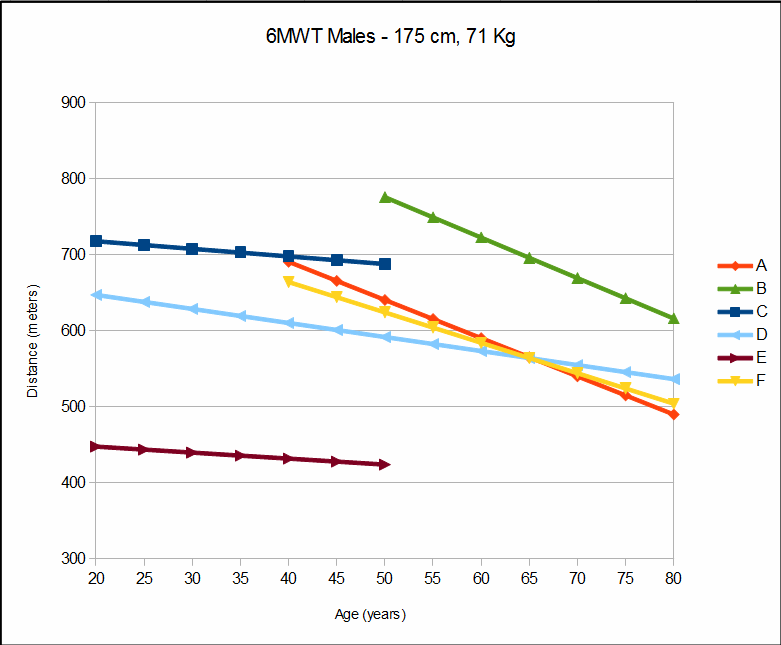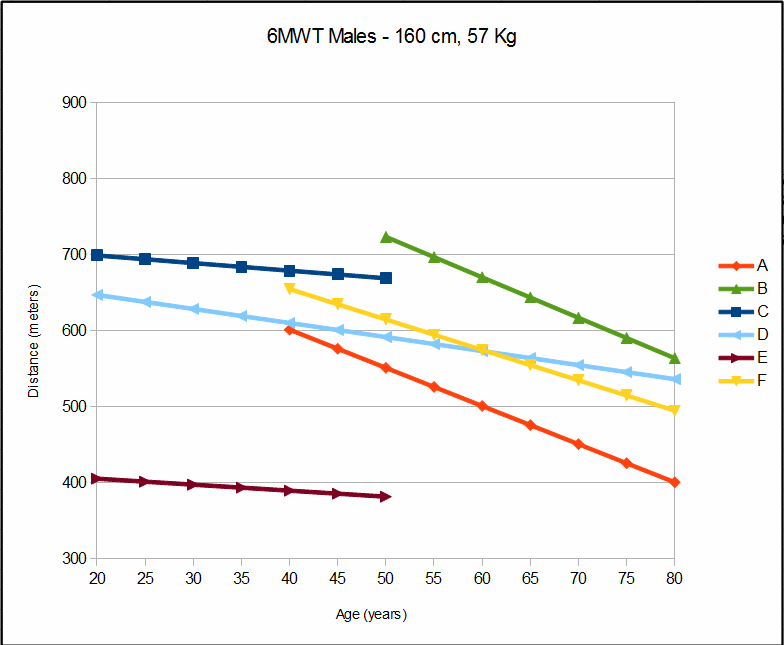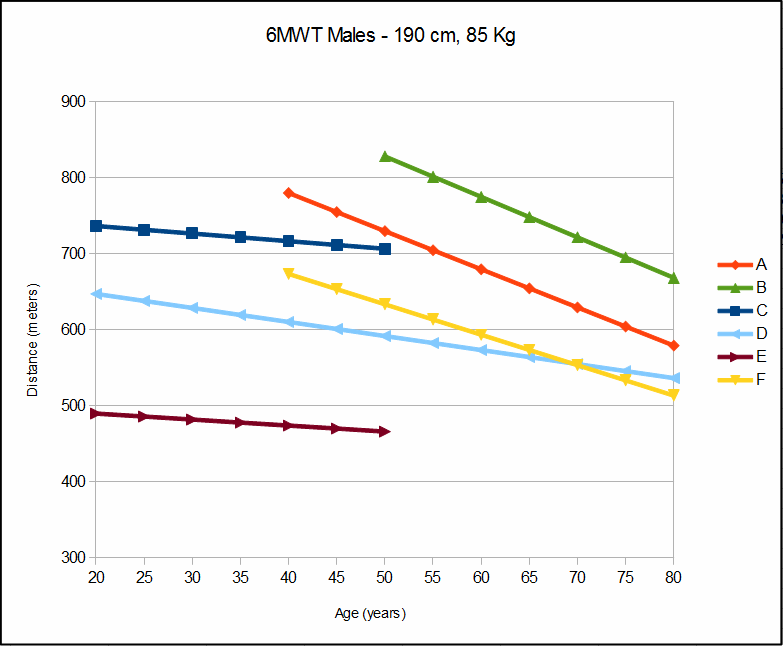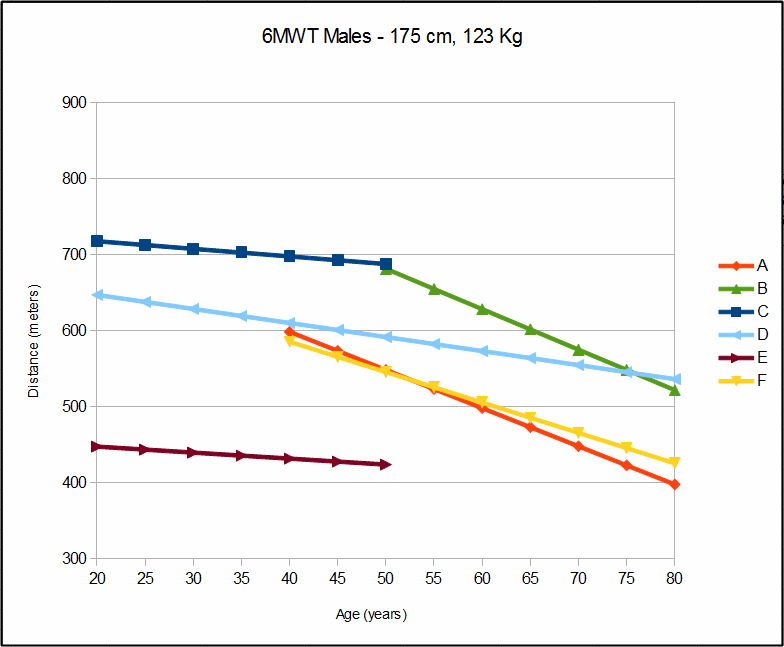The distance attained during a 6-minute walk (6MWD) has been used extensively to assess the functional capacity of patients with a variety of diseases and conditions. It is relatively easy to perform and requires a minimum of equipment. Changes in 6MWD before and after rehabilitation, surgery, or medications are often used to signal the success or failure of these therapies. For the last dozen years every drug and device research study my lab has been involved with has used the 6MWD as one of their outcomes.
The 6-minute walk distance has been noted to depend on the age, gender, height and weight of the individual. There are, however, relatively few studies to choose from when it comes to selecting normal values for the 6MWD and each of these studies differs not only in the degree of importance it assigns to these variables but in the predicted 6MWD. Despite the clinical significance of changes in the 6-minute walk distance it is far from clear what a normal 6-minute walk distance actually is.
It is hard to criticize the studies that have attempted to determine a normal 6MWD. The studies have all adhered to the ATS 6-minute walk test guidelines and most have used similar exclusion factors. Patients with an active involvement in a competitive sport, a chronic disease that would affect exercise capacity, a BMI > 35, a FEV1/FVC ratio below 0.70 or the use of beta blocker or calcium channel blocker medications have been excluded. Most subjects performed more than one 6MWT separated by at least a couple of days and the highest 6MWD was used in the analysis. The most obvious difference between studies were the ages of their subjects. For males, these ages and equations are:
| Equation | Year | Author | No. | Ages |
| A | 1998 | Enright et al | 117 | 43-77 |
| B | 1999 | Troosters et al | 29 | 50-85 |
| C | 2006 | Chetta et al | 48 | 20-50 |
| D | 2009 | Iwama et al | 61 | 14-84 |
| E | 2009 | Alameri et al | 127 | 18-50 |
| F | 2011 | Casanova et al | 238 | 40-80 |
Reference equations:
| A | (ht x 7.57) – (5.02 x age) – (1.76 x wt) – 309 |
| B | 269.31 + (ht x 5.14) – (age * 5.78) – (wt x 2.29) |
| C | 518.853 + (ht x 1.25) – (age x 2.816) |
| D | 622.461 – (age x 1.846) |
| E | (ht x 2.81) – (age x 0.79) – 28.5 |
| F | 361 + (ht x 2) + (% max hr/pred max hr) – (age x 4) – (1.5 x wt) |
Because females have been noted to walk a shorter distance than males it is apparent that gender does make a difference but in general the reference equations handle gender quite simplistically. With only one exception the same reference equations for men are used for females and a constant subtraction factor (which is applied to all ages, heights and weights) is included:
| Equation | Factor |
| A | (ht x 2.11) – (wt x 2.29) – (age * 5.78) +611 |
| B | -51.31 |
| C | -39.07 |
| D | -61.503 |
| E | 0 |
| F | -30 |
It seems obvious that the other factors affecting the 6MWD would be age, height and weight. There is universal agreement that age is an important factor, but a look at the 6MWD regression equations shows that there is a fair amount of disagreement concerning its significance since the weighting factor ranges from 0.79 to 5.78. This, however, does not appear to be due to the different age ranges used in the studies since studies with similar age ranges can have quite different age factors and studies with quite different age ranges can have similar age factors.
It would also seem intuitive that height would affect stride length and would therefore affect an individual’s 6MWD but at least one study did not find height to be a significant factor. Among the remaining studies the height factor ranges from 1.25 to 7.57. The effect of these factors on individual reference equations are most apparent at the extremes of the normal height range.
Numerous studies have shown that the 6MWD is lower when subjects are obese, yet despite this half of the reference equations do not include body weight. This may be due to the fact that obese patients have been excluded from most reference studies so that differences in weight among the remaining participants is no longer statistically significant. This may be why the weight factor shows the least variation amongst the reference equations with a range of 1.5 to 2.29.
Several researchers have calculated a value called the 6MWD work (6MWDW or 6MWork) by multiplying the subject’s body weight (in kg) times the distance (in meters). Although obese patients have a lower 6MWD they usually have a larger 6MWork value than their leaner counterparts. A threshold value of 25,000 kg-M has been proposed where patients below this value have a significantly higher mortality risk. This is an interesting concept but at this time there are no reference equations for 6MWork.
Casanova et al studied the 6MWD from populations around the world and noted that there were significant differences between geographic areas that could not be explained by height, weight or age. The difference between reference equation C, which is from an Italian study group and E, an Arabian study group with reasonably similar ages, heights and weights is quite dramatic and this alone makes it clear that attempting to determine whether or not a 6MWD is normal is very problematic.
There are marked differences between the various 6MWD reference equations and the reasons for these differences are far from clear. At least part of this may be due to the relatively small number of participants in each research study which makes statistical analysis of the results more dependent on small differences in the study group. Gender, age, height and weight are obvious factors in determining a normal 6MWD but other unknown factors appear to be just as important.
In 2002, the ATS statement on the 6-minute walk test stated that “Optimal reference equations from healthy population-based samples using standardized 6MWT methods are not yet available.” Over a decade later this statement still applies and it still appears that the best and most appropriate use of the 6MWD is in serial comparisons for the same patient.
Update:
This topic was extensively updated with numerous additional reference equations in 6MWT re-visited. Now with the MCID!
References:
Alameri H, Al-Majed S, Al-Howaikan. Six-min walk test in a health adult Arab population. Resp Med 2009; 103: 1041-1046.
ATS Statement: Guidelines for the six-minute walk test. Amer J Respir Crit Care Med 2002; 166: 111-117.
Casanova C, et al. The 6-min walk distance in health subjects: reference equations from seven countries. Eur Respir J 2011; 37: 150-156.
Carter R, Holiday DB, Nwasuraba C, Stocks J, Grothus C, Tiep B. 6-minute walk work for assessment of functional capacity in patients with COPD. Chest 2003; 123: 1408-1415.
Chetta A, et al. Reference values for the 6-min walk test in healthy subjects 20-50 years old. Respir Med 2006; 100: 1573-1578.
Cote CG, et al. Validation and comparison of reference equations for the 6-min walk distance test. Eur Respir J 2008; 31: 571-578.
Enright PL, Sherril DL. Reference Equations for the six-minute walk in healthy adults. Amer J Respir Crit Care Med 1998; 158: 1384-1387.
Iwama AM, Andrade GN, Shima P, Tanni SE, Godoy I, Dourado VZ. The six-minute walk test and body weight x walk distance product in healthy Brazilian subjects. Braz J Med Biol Res 2009; 42: 1080-1085.
Larsson UE, Reynisdottir S. The six-minute walk test in outpatients with obesity: reproducibility and known group validity. Physiother Res Int 2008; 13(2): 84-93.
Troosters T, Gosselink R, Decramer M. Six minute walking distance in healthy elderly subjects. Eur Respir J 1999; 14: 270-274.

PFT Blog by Richard Johnston is licensed under a Creative Commons Attribution-NonCommercial 4.0 International License.




